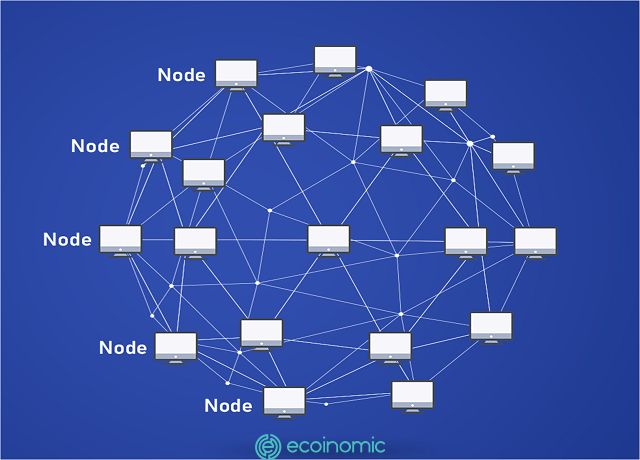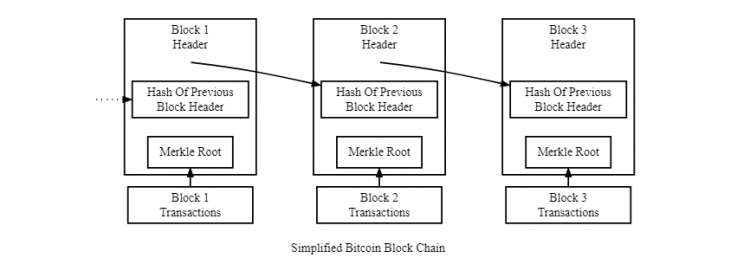Advertisement
What is a node?
Nodes help store, transmit, and preserve blockchain data. So, in terms of theoretical wear, a blockchain exists on nodes. The core of blockchain is based on the principles of the P2P (Peer to Peer) network. In most networks, there is no central server but the consensus between nodes.
The node can be any type of device, it can be PCs, Laptops, or larger servers,… Nodes form the infrastructure of a blockchain. All nodes on a blockchain are connected to each other, they constantly exchange the latest data with each other so that all nodes are always up to date.

How does the node in the blockchain work?
When a miner or Validator attempts to add a new transaction block to the Blockchain, they transmit the Block to all (or in part, depending on the blockchain’s Consensus algorithm using) the nodes on the network.

Based on the legitimacy of the Block (the validity of the signature and transaction), nodes can accept or reject that Block. When a node accepts a new transaction block, it stores it on top of the remaining blocks it has stored. Here’s what nodes do:
- Nodes check if a transaction block is valid and accept or reject it.
- If accepted, the nodes will host the transaction blocks (which store blockchain transaction history).
- Nodes play and spread this transaction history to other nodes to synchronize with blockchains.
Node Classification in Blockchain
There are two main types of nodes:

Full Node
Full Node acts as a server in a decentralized network. Its main tasks include maintaining consensus among other nodes and verifying transactions.
It also stores a copy of the Blockchain, thus being more secure and allowing for advanced functions such as voting rights for proposals in the network. Some of the main characteristics of a full node:
- Full storage of blockchain data.
- Join block confirmation, and verify all blocks and status.
- All states can originate from the full node.
- Provide on-demand data for lightweight nodes.
Lightweight nodes
Another type of node is used in everyday cryptocurrency operations.
These types of nodes communicate with the Blockchain while relying on full nodes to give them the necessary information. Since they don’t store copies of the entire blockchain, they only query the current state to process transactions.
Running lightweight nodes doesn’t require a lot of resources, but it does sacrifice security for the sake of convenience.
See also: What is Modular Blockchain? Why is Modular Blockchain considered the future of blockchain?
Bitcoin Nodes
Running a Bitcoin node means using bandwidth resources (transmitting the available data in 1 second) and a backup computer that allows BTC users to send transactions and receive notifications about any activity in their digital wallet. Running a Bitcoin node is not the same as Bitcoin Mining – there is no block reward for running a full Bitcoin node.
To run a full Bitcoin node., you must visit the official website of Bitcoin Core and download the deployment software. According to the developer team’s website, you need to meet certain requirements before you can become a full node runner.
Previously, running a full node of Bitcoin Core required downloading the entire blockchain. Thankfully, the trimming allows individuals to run full nodes without requiring large storage requirements. Instead of allocating 350GB of disk space, full node operators only need 7GB.
The requirements for full node have been removed:
- Desktops or laptops running recent versions of Windows, Mac OS X, or Linux.
- 7 GB of storage, accessible at a minimum read/write speed of 100 M/s.
- Memory (RAM) 2GB.
- Connect to the Internet with an upload speed of at least 400 kilobits (50 kilobytes) per second.
- At least six hours a day so that your full button is kept active.
Note that running a Bitcoin node comes with potential risks and additional costs. In some countries, any form of Bitcoin activity, including running a node, is prohibited. Bitcoin nodes are also vulnerable to attacks by hackers intent on exploiting the network.
Ethereum Nodes
In Ethereum, users can run three different types of nodes: lightweight, full, and storage. Their difference lies in the speed at which it can be synchronized with the entire network.
There are many ways to run your own Ethereum node, but some common hardware that can work on the network are DAppNode and Avado. Ethereum nodes have almost the same requirements as Bitcoin nodes, only other than previous nodes that required less computing power.
Note that before you run an Ethereum node, you should check your bandwidth limit first.
You can find a list of customers that you can use to run a node on Ethereum’s website.
Ethereum nodes are essential in keeping the Blockchain network safe and reliable and transparent. In fact, anyone can view nodes and their performance on the network through the Etherscan node tracker.
To receive a block reward, you will have to run an Ethereum betting node.
Monero Nodes
Monero nodes are run by a program called “daemon”. However, operating a full node has higher storage and bandwidth requirements than Bitcoin. Keep in mind that running a Monero node is different from mining Monero for block rewards.
Since Monero’s latest release, the recommended storage capacity is around 30GB and will increase over time (according to the Monero website’s 2018 guidelines). In addition, users will need a fast internet connection to be able to synchronize the entire blockchain without delay.
Nodes can run on Windows, Linux, and Mac. A complete guide on how to set up an accessible Monero button on its website.
Bitcoin Cash Nodes
The role of Bitcoin Cash nodes is similar to how other nodes work: they contribute to network security and help verify transactions. Like the aforementioned blockchain networks, the BCH network also allocates rewards to nodes involved in mining – although running a node without mining will not result in rewards.
Bitcoin Cash is a fork of Bitcoin that is prioritized to increase the block size, which is why it has a relatively large Blockchain size of 194 GB (as of May 10, 2021) despite having fewer transactions than BTC.
Dash Nodes
Dash uses active “masternodes” to ensure blockchain security and consensus, requiring users to keep at least 1,000 DASH as collateral and own a computer running the latest Linux update.
The main role of the masternode is to store copies of the full Blockchain state and help facilitate the settlement of transactions such as sending assets and changing names.
Like miners, masternodes are rewarded for the service they provide to the network. You can run a masternode by following the instructions in Dash’s official document.
Binance Smart Chain Nodes
The Binance Smart Chain node is tasked with verifying the status of existing accounts on the Blockchain. BSC operators have a full copy of the network and provide feedback to network-based queries if needed.
Currently, the full is only supported on Mac OS X and Linux. Here are the recommended requirements needed to run a full or an authentication node on BSC.
See also: Binance Smart Chain Ecosystem – From DeFi To MetaFi
Full Node
- VPS runs updated versions of Mac OS X or Linux
- 1TB of storage
- Computer processor with eight CPU cores
- 32GB memory (RAM)
- Connect to the Internet with a upload/download speed of at least 1 megabyte per second
Validator
- VPS runs updated versions of Mac OS X or Linux.
- 2TB storage
- Computer processor with eight CPU cores
- 32GB memory (RAM)
- Connect to the Internet with a upload/download speed of at least 1 megabyte per second
Chainlink Nodes
The role of chainlink nodes is to support the predictive functionality of the protocol, which allows the execution of data requests without compromising security and reliability. They also complement the operation of smart contracts by ensuring that they are provided with real-world data appropriately.
To launch a node, users must run data connection software on the chain and off-chain and a contract that monitors every data query and response to their request.
















